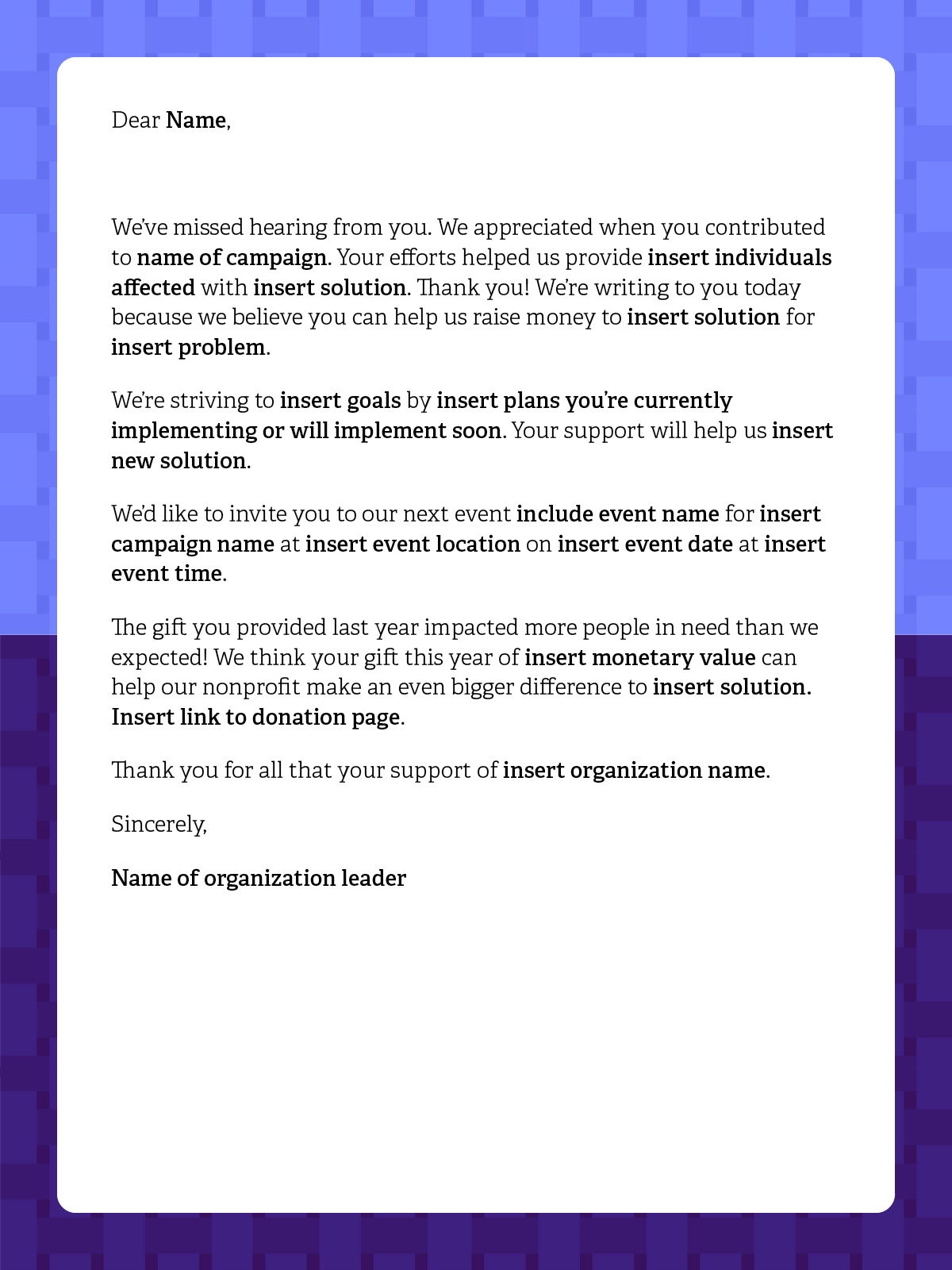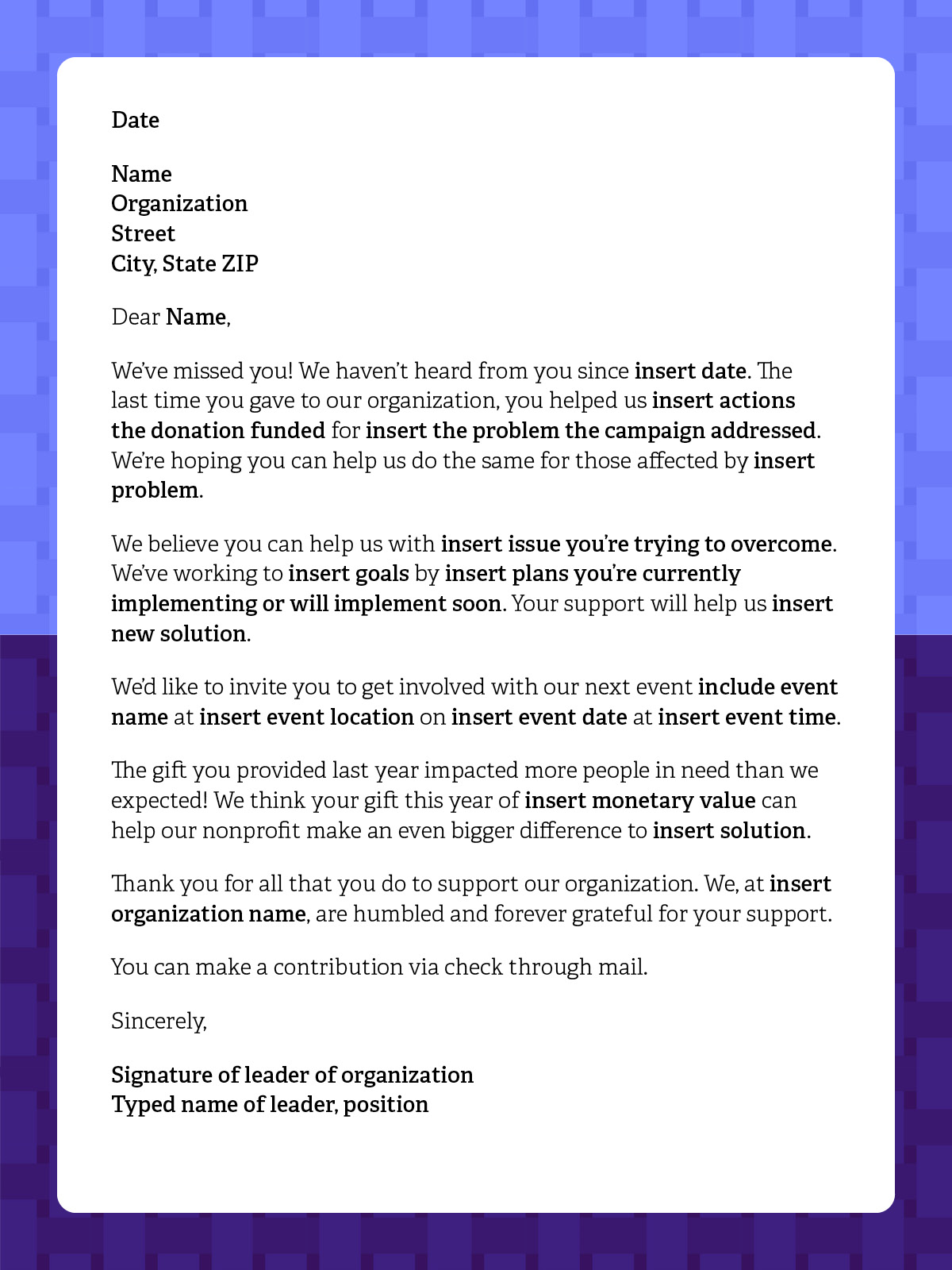While your nonprofit organization may excel at donor retention, acquisition, and stewardship, donors are bound to fall through the cracks and lapse over time. The good news is that these supporters have confirmed their interest in your organization through their past involvement, which can make them an easier target than new supporters.
Sending letters to inactive supporters is an easy, yet effective tactic to remind them of your organization’s cause. Making your lapsed donor letters personalized, emotional, and data-driven will boost your retention rate and secure your donors’ support for years to come. Here are six easy steps for you to regain your lapsed donors.
1. Identify lapsed donors
While every organization and donor management software provider has a different definition for what makes a lapsed donor, most nonprofits identify them as supporters who haven’t given or otherwise engaged with your nonprofit in over 12 months.
Use your fundraising software along with your CRM to determine who your lapsed donors are. Set filters within your CRM based on the last time donors have given. Then, check your volunteer records within the same time filter. If you need a CRM built for segmentation, Bonterra Donor Engagement Fundraising solution allows you to compile detailed donor data that makes segmenting a breeze.
2. Segment your donor communication streams
Donors should receive messages that appeal to their unique preferences and interests, so it makes sense to categorize them by the date of their last engagement. You might choose segments such as:
- Time lapsed
- Average donation amount
- Total time spent engaged with the organization
- Preferred mode of communication
- Age
- Income
Segmenting donors provides an additional level of personalization to your outreach. To choose the right metric to segment, modify your language for the appeal based on how long they’ve lapsed. For instance, recently lapsed donors might receive more casual approaches while donors who haven’t given in a few years might receive more direct appeals.
Be sure to choose language that is warm, welcoming, and progresses appropriately for varying donors.
3. Mention the donors’ past engagement
No donor is the same, which means no lapsed donor stopped giving for the same reason as another. Your donors will be able to tell when you send out mass emails and mass letters because they’ll be missing one thing: personalization.
When reaching out to lapsed donors, you want them to understand how much you value their support in particular, so you’ll want to customize the content in your appeal. Address them by their names, reference past projects they gave to, and tailor your fundraising ask to their average giving amount. Include copy like this in your approach:
- The last time you gave to our organization, you helped us build shelters for those affected by the hurricane. We’re hoping you can help us do the same for those affected by the latest earthquake in Mexico City.
- We appreciated it when you contributed to our “No Child Left Behind” campaign. Your efforts helped us provide children in need with backpacks, books, and other school supplies. We’re writing to you today because we believe you can help us raise money to offer English classes to children in developing nations.
- With your previous recurring donations, you saved 31 abandoned animals. From your donations alone, we were able to supply animals in need with kennels, beds, food, and more. But there are still animals who need our help, which is why we’re writing to you today.
This approach will stress just how much you notice the difference when you don’t have their support. In other words, this will help emphasize how much you miss them, yet again.
Since you’ll be writing such tailored approaches, you’ll want to select quality lapsed donors to focus on in efforts to maximize your potential profit. Streamline the letter-writing process by only selecting the most impactful donors for your outreach strategy. You might determine this by the lapsed supporter’s average donation amount or time spent engaging with your organization.
4. Tell lapsed donors you miss them
Your letters and emails should communicate how much you miss your supporters. To effectively portray how much your organization misses them, use language like the following:
- “We miss having you as part of our nonprofit family!”
- “We’ve missed hearing from you.”
- “We haven’t heard from you since September 2020.”
Find a way that voices your concern for their personal well-being while thanking them. Remind them when you last heard from them or the last time they were involved with your organization—they may have simply forgotten to donate!
Regardless of the wording you end up using, ensure you make them feel like they were part of something authentic and life-changing for your beneficiaries.
5. Invite your lapsed donors back
Provide your lapsed donors with an easy road to reconnection with your nonprofit by giving them actionable next steps to get involved based on their past engagement and preferences. For instance, if they previously volunteered at your fun run a few years back, invite them to volunteer again with a similar opportunity.
On the other hand, if the lapsed donor doesn’t have any preferred engagement channels, you might offer the option of participating in your peer-to-peer campaign. This way your lapsed donor can simply use their network and restart their involvement with your organization easily.
The bottom line? Give your constituents a diverse range of opportunities for re-engagement. This way, you won’t lose out on lapsed supporters by failing to offer them the opportunities that excite them the most.
6. Send letters via your lapsed donors’ preferred communication channels
Delivering your message through your donor’s favorite communication channel proves that you know and value their preferences. Thus, if your tailored message reaches your lapsed donor through their preferred method, you’ll increase the likelihood of winning them over.
You’ll likely split your donors into two groups: those who prefer email, like younger donors, and those who prefer letters, who may be older donors. Let’s explore the differences between a donor appeal sent via email versus via direct mail.
Email template

Direct-mail template

The main difference between these appeals is the listed action of donating. While those who prefer mailed letters would most likely prefer to mail in a check, those who prefer emails will probably prefer to be redirected to your online donation page.
You can ask lapsed donors for contributions that are the same as their average donations or the same as their smallest donations. Whatever amount you decide to ask for, just make sure it’s plausible and asked for with grace and gratitude.
Getting started regaining lapsed donors
Now that you have our easy six-step process for regaining lapsed donors, you’re sure to have an ever-expanding donor database. Remember to collect data on your success rate with new communication methods and adjust your approach over time. Good luck stewarding your lapsed donors!




